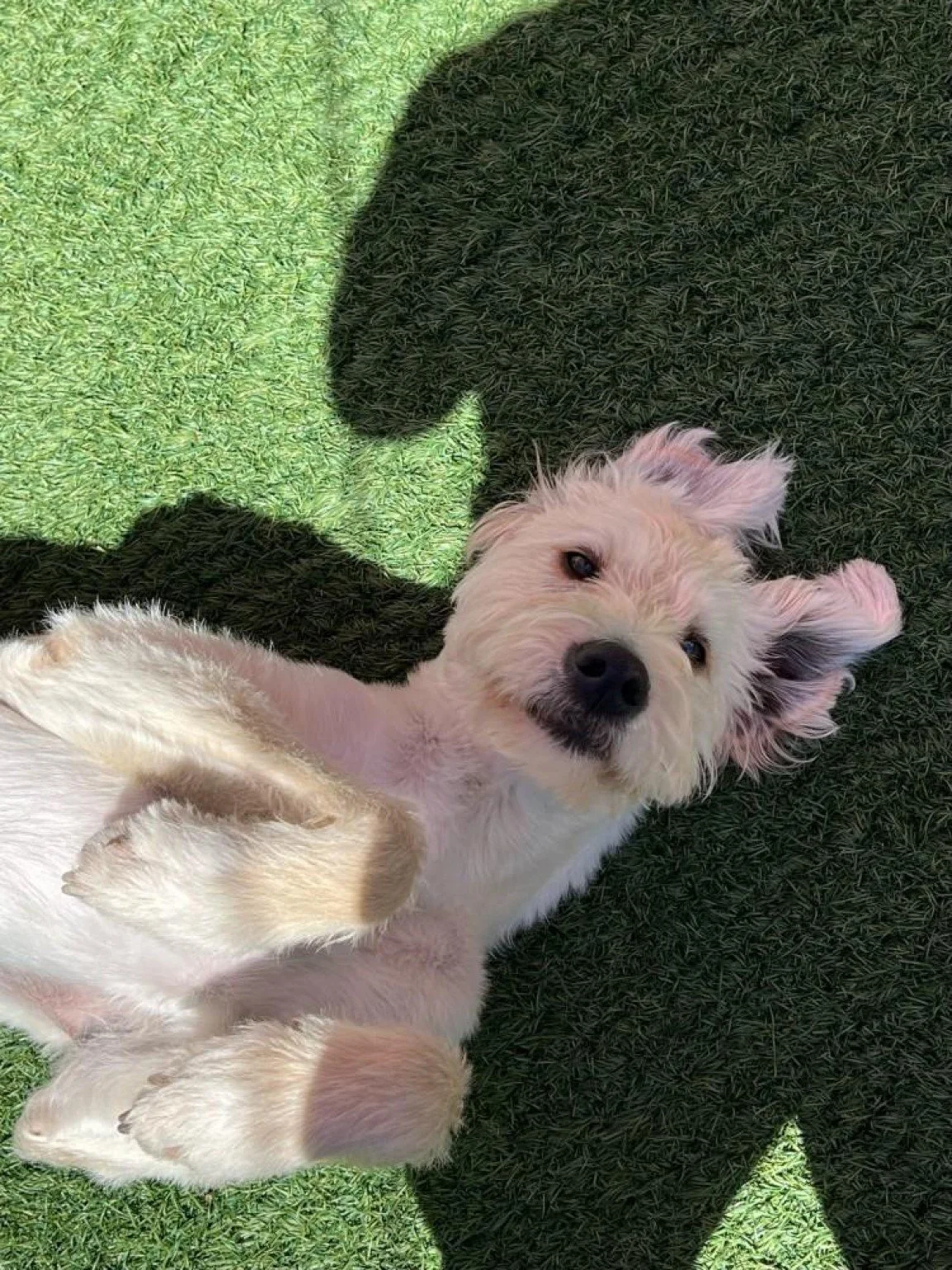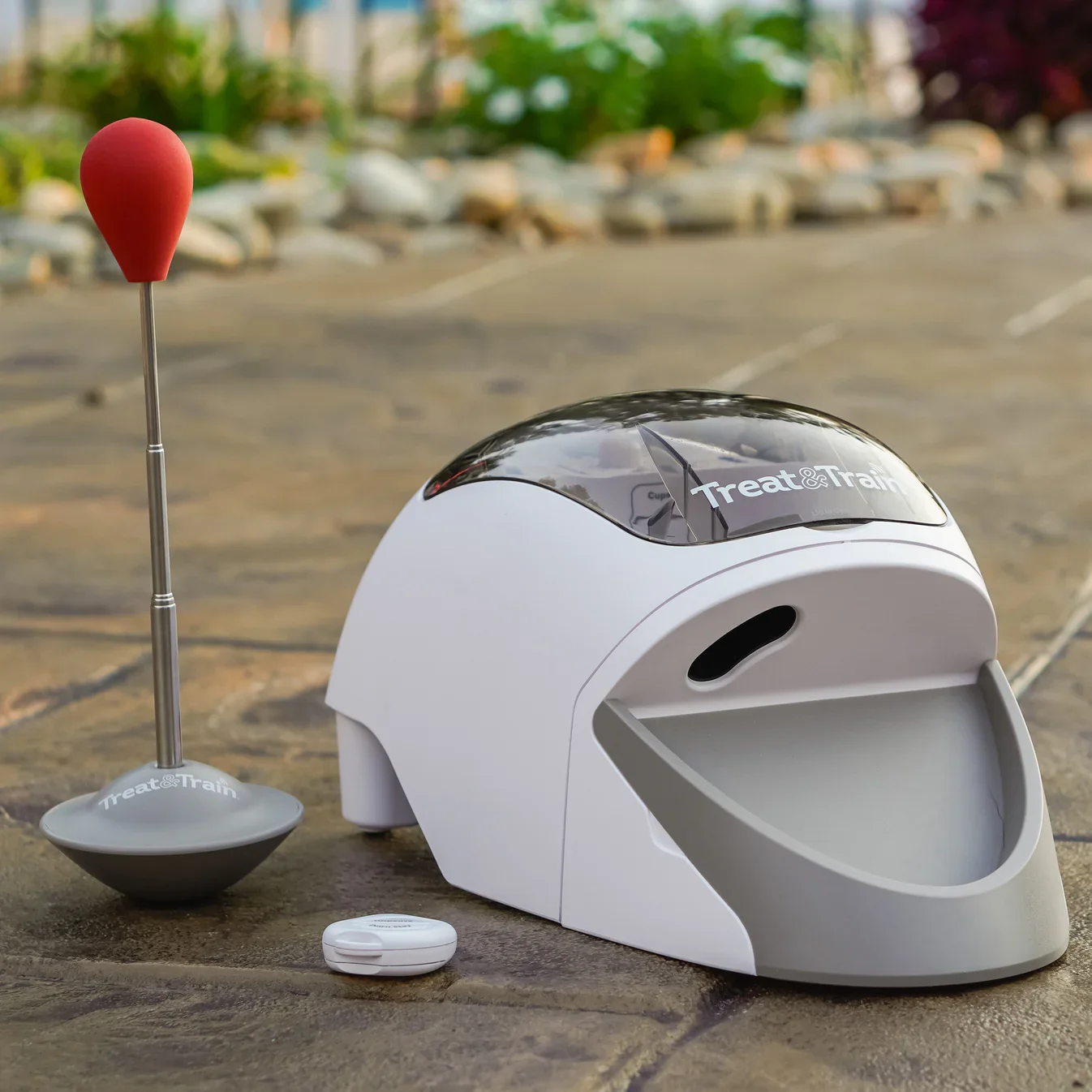Free Tools & Resources
Everything you need to start your separation anxiety training journey — vetted tools, free downloads, and resources that actually work. I've tested most of these myself with Grizzy, and I only recommend what I genuinely believe will help.
I am not a certified dog trainer or behaviorist. I'm just a dog parent who's been in your shoes — full of guilt and fear, researching at 2am, wondering if we'd ever figure this out. Through lots of trial and error, I've learned what actually works for separation anxiety and what doesn't.
Free Separation Anxiety Training Tracker
Your personal roadmap to freedom — one small step at a time.
This comprehensive, 30-page tracker was designed to use alongside your Pleasantly Independent handbook by Jenn Gavin, BA, CPDT-KA, help you stay consistent, celebrate every win (no matter how small), and have a clear record of your dog's progress. When motivation dips or you feel stuck, you can flip back through these pages and see exactly how far you've come.
Your Essential Blog Guides
These posts are the foundation of separation anxiety training. I'd recommend reading them in the order below:
Separation anxiety isn't misbehavior — it's a panic disorder. This guide explains what's actually happening in your dog's brain when you leave, why traditional training methods fail, and how recognizing SA as a medical condition changes everything about your approach.
You'll learn: The difference between SA and simple disobedience, why your dog can't just "get over it," and what recognition of SA as a panic disorder means for your training strategy.
Start here if you're newly diagnosed.
This is the full training blueprint — everything Grizzy and I learned through a year and a half of trial and error, condensed into an actionable guide. It includes all five phases of training, realistic timelines, the tools that matter, and honest expectations.
You'll learn: How to desensitize pre-departure cues, implement classical conditioning, build duration gradually, add real-life variables, and when to seek professional help.
The most important strategies that acually work.
If you want to know where I'm coming from and understand the emotional side of this journey, read our story. It covers the panic, the guilt, the small victories, and how Grizzy and I eventually got our freedom back. As of today, we are consecutively hitting 3-4 hr departures!
You'll learn: What the early days looked like, the mistakes we made, how we found the right trainer, and what finally worked for us.
The real, messy journey that led us here.
Recommended Tools & Products That Help
Books
Pleasantly Independent by Jenn Gavin, BA, CPDT-KA
Pleasantly Independent: A Handbook for Separation Anxiety in Dogs by Jenn Gavin, BA, CPDT-KA
This handbook was absolutely essential to our training journey. Jenn Gavin is a certified professional dog trainer and behavior consultant who specializes in separation anxiety. Her approach is grounded in science and focuses on classical conditioning — the same method that worked for Grizzy.
Why it's valuable: Clear, practical guidance on implementing classical conditioning specifically for separation anxiety. No fluff, no upselling, just solid training advice.
What it covers: Understanding SA, pre-departure cue training, classical conditioning implementation, common mistakes, and troubleshooting.
Cost: $24.99 USD
My note: This handbook was my SA Bible and really helped outline clear next steps throughout the training process with Grizzy. It was like having a trainer in my pocket.
Essential Tools
Treat & Train Treat Dispenser
This is hands-down the most effective tool we used during Grizzy's training. It's a Wi-Fi-enabled automatic feeder that dispenses treats on a timer or remotely via your phone. But more importantly, it enables classical conditioning — your dog learns that your leaving predicts treats, not panic.
Why it works: Your dog isn't just waiting for you to come back; they're actively engaged with something positive. Over time, their brain rewires to associate your departures with rewards instead of fear.
How we used it: We started with Grizzy getting treats from the machine while we were still home, helping increase his independence while we were around. Then we paired it with pre-departure cues (picking up keys, moving toward the door). Eventually, the machine turning on became a positive signal that we were about to leave.
Cost: $149.99 USD
My honest take: This is not a forever crutch. As your dog becomes more comfortable, they need it less, just like Grizzy experienced. Think of it as training wheels that you'll eventually remove — but while you need them, they're invaluable.
Find it Here | Pro-tip: check out Facebook Marketplace for a more affordable, gently used one!
Video Monitoring Cameras
This might be the most important tool after the Treat & Train. You need to see exactly how your dog responds when you leave — not just assume. Are they calm? Stressed? Eating treats or ignoring them? Video gives you the data you need to adjust your training.
Why it matters: Many dogs look fine to their owners but are actually stressed (elevated heart rate, panting, constant vigilance). Video monitoring shows you the truth so you can make informed training decisions. Also very important if you’re working with a trainer so that you can share the footage with them to get an honest, personalized assessment of their behaviors.
Cost: $30-100 USD depending on features
My recommendation: Get a camera before you get anything else (after the Treat & Train). You can't train effectively without knowing what's actually happening. We bought a few and made sure to place each one near Grizzy’s relaxation spots. You can even setup your laptop, flip it to where your Treat & Train is setup, and create a fake Zoom call or video recording to capture your dog’s behaviors if you’re in a pinch!
Alternative Tools (If Treat & Train isn’t an option)
Kong Toys & Licky Mats
Stuffable chew toys that keep your dog engaged. Freeze peanut butter, greek yogurt, pumpkin, or your favorite pup’s treat inside for extended engagement. Not as effective as the Treat & Train for classical conditioning, but helpful for distraction and mental stimulation.
Cost: $8-15 USD
Best for: Dogs who aren't highly food-motivated or as a supplement to other training methods
Puzzle Feeders & Snuffle Mats
Mental enrichment activities that slow down eating and keep your dog engaged. Helpful for creating positive associations with your absence.
Cost: $10-25 USD
Best for: Dogs who enjoy problem-solving and foraging behaviors
Calming Supplements & Anxiety Aids
CBD, L-theanine, TheraPet pheromone diffusers, or Thunder Shirts
I'll be honest: we did not see any real difference using these with Grizzy. But they may take the edge off enough for some dogs to participate in training.
My honest assessment: These aren't a solution, but they might be a tool. If your dog's anxiety is so severe they can't engage with training, talk to your vet about these options. They're not the answer, but they might help create conditions where the answer can work.
Cost: Varies widely, $20-80+ USD / month
When to consider: If your dog's anxiety is severe and they're not responding to training, or while you're waiting to start working with a professional
Finding Professional Help
What Qualifications to Look for
CSAT (Certified Separation Anxiety Trainer) The gold standard for SA specialists. These trainers have completed rigorous training and certification specifically for separation anxiety. They understand the nuances that general trainers miss.
CPDT-KA (Certified Professional Dog Trainer - Knowledge Assessed) A general certification, but when combined with SA experience, indicates a serious, knowledgeable trainer.
IAABC Certified (International Association of Animal Behavior Consultants) Members follow a code of ethics and use science-based methods.
Veterinary Behaviorist (DVM + behavior specialty) A veterinarian with additional certification in animal behavior. Can prescribe medication if needed and provide medical guidance alongside training
Red Flags to Avoid
❌ "Quick fixes" - Anyone promising results in a week or two is selling you something. SA training takes time.
❌ Outdated methods - "Just ignore the barking," "crate and expose," "tough love." These often make SA worse.
❌ No SA experience - General dog trainers may not understand the specialized approach SA requires.
❌ Won't communicate with your vet - SA often benefits from medication. Good trainers work alongside veterinarians or will strongly recommend you to connect with yours.
❌ Pressure to commit long-term without results - Reputable trainers will show progress and adjust their approach if something isn't working.
❌ No customization - One-size-fits-all programs rarely work for SA. Your dog deserves a tailored approach.
Cost Expectations
In-Person Training:
Initial consultation: $100-300
Weekly sessions: $100-300 per hour
Board and train programs: $2,000-5,000+ for 2-4 weeks — be cautious with this one. Board and Train may not be the most suitable program for separation anxiety and could likely make things worse. Be sure to consult with your vet and/or behaviorist before signing your dog up for one of these programs.
Virtual/Remote Training:
Consultation: $50-150
Ongoing sessions: $75-200 per hour
Group Classes:
More affordable: $100-300 for a course
Less customized but still helpful
Questions to Ask Before Hiring
How much experience do you have specifically with separation anxiety? Look for at least 2+ years and numerous SA cases
What methods and tools do you recommend? They should mention classical conditioning or desensitization, never aversive methods
Do you work with veterinarians? Good trainers collaborate with vets, especially if medication is involved
Can you observe my dog? Video observation is minimum; in-home observation is ideal
What's your success rate? They should be honest about timelines and realistic outcomes
How do you charge? Flat fee, hourly, package? What's included?
What happens if I hit a plateau? Do they adjust the plan? Offer support? Continue working with you?
Can you provide references? Talk to people they've worked with and ask for reviews
Where to Find Trainers
Your Veterinarian: Ask for referrals to behaviorists or trainers they recommend
Local Veterinary Behaviorist: Check with local veterinary schools or animal hospitals
Community: Friends of friends, local Facebook groups, Doggy Daycares, Groomers — ask around! You never know what you may find out.
Our Experience: Our trainer was a LITERAL game-changer. We found her on a local Facebook group titled ‘TC Reactive Dogs’. She could watch video of Grizzy and catch stress signals I completely missed. She gave us customized tweaks that sped up our progress by months. It was one of the best investments we made.
Understanding SA: Key Terms Explained
-
A panic disorder where a dog experiences genuine fear and panic when separated from their owner(s). It’s a medical condition, not misbehavior.
-
In the same camp as separation anxiety, except instead of the panic response being tied to a single person, it is about being alone, period. They’re fine as long as someone is around but painc when the house empties.
-
The veterinary classification for separation anxiety. It’s a medical condition involving brain chemistry and panic responses, not a training or behavioral issue.
-
Actions that signal you’re about to leave (grabbing keys, putting on shoes, picking up your bag). Dogs learn to predict departure from these cues, often becoming anxious befoe you even start moving out the door.
-
Pairing a neutral stimulus (your departure) with something positive (treats) until the dog’s brain associates the neutral stimulus with the postive outcome.
-
Gradually exposing a dog to a fear-trigger in small doses until they’re less reactive. Slower than classical conditioning but still effective.
-
The point at which your dog begins to show stress. Successful training stays below this threshold.
TRENDING • TRAINING INFO
How to Start Your Separation Anxiety Plan
READ MORE






